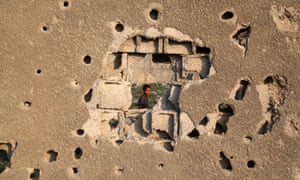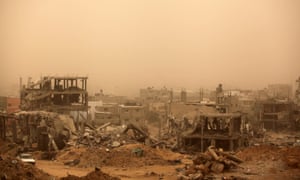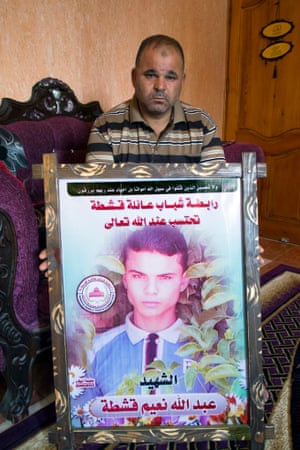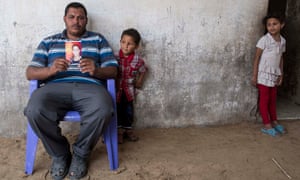Peter Beaumont
in Rafah
Link

The walls of the office of Salim Abu Rous, headmaster of the Doha boys’ secondary school in Rafah, in the south of the Gaza Strip, are decorated with medals and trophies. He has photo albums of the boys in football teams and other clubs.
About 1,000 pupils attend his school, arriving in two shifts – so many that he struggles to remember the names of all the boys killed in last summer’s war.
“I remember Haitham Abdul Wahab,” he says finally, flicking through one of the picture albums to try to find him. “He was a good boy. He was well loved in the school. He was killed at his uncle’s house with his brother and mother.”
Six pupils from the Doha school were killed in the war, more than from any other school in Gaza. In total, more than 550 Palestinian children died during the conflict. Across Gaza, schools lost pupils and teachers, and thousands were injured.
Salim Abu Rous’s difficulty in remembering all the dead boys is understandable given some had not long transferred into his large school.

But there is another, grimmer, reason. “There were so many deaths in the last war,” he says – so many it was hard to process them. The consequence is that, on an institutional level at least, it appears as though the boys have been almost erased from the school’s memory.
But in their homes in neighbourhoods and villages across the Rafah area – which saw some of the heaviest attacks of the 50-day war – the anguish is still raw.
Anas Muamar was 16 when he was killed on 20 July last year.
“It was two o’clock in the morning. We weren’t sleeping here. It was too dangerous. So we were staying in another place we thought was safer,” recalls his father, Mahmoud Hussein Mahmoud Muamar, a former employee of the religious affairs ministry.
“There was a very loud explosion. Anas had been sleeping but woke up and went to the balcony to see what had happened. After a while they went back inside. That’s when the house was hit again. His two brothers were killed and Anas was injured.”

Mahmoud’s face crumples into tears. “We took him to the hospital … but he died. He was a good boy. He was a good student who liked football and followed Barcelona. He was religious, like his brothers. This year he was supposed to have been in the twelfth grade. I wanted him to go to university and become a teacher.”
Gaza’s youngest residents still appear to be bearing the heaviest and most lasting consequences of last summer’s war. A report published on Monday by Save the Children, entitled A Living Nightmare: Gaza One Year On, says 551 children were killed and 3,436 were injured, of whom 10% suffered permanent disability. One Israeli child was killed during the war, and 270 injured.
Three-quarters of Gaza’s children experience unusual bedwetting regularly, the report says, while 89% of parents report that their children suffer constant feelings of fear, and more than 70% of children say they are worried about another war. Seven out of 10 children interviewed now suffer regular nightmares.
What is also clear is that the loss of older teenagers – such as the six Doha pupils on the brink of adulthood – has affected younger siblings and parents, compounding a deepening sense of fatalism and hopelessness in a Gaza where the promised reconstruction has barely happened and whose outlook, Palestinians say, seems bleaker than at any time in recent memory.
A green Hamas flag flies above the family compound where Muhammad Behabsa, 17, died, off a sandy lane in the Salaam district of Rafah. There seems little question that the house and five others beside it, occupied by relatives, were the intended Israeli target.
Like many living in areas heavily hit by military strikes during the war, the Behabsa family still live next to the ruins where their family members died. The main house was hit in an air strike that left a crater still visible in the dusty yard. A little later several smaller houses belonging to family members behind the compound were reduced to rubble in a second set of strikes, apparently by artillery fire.
“It happened at three o’clock in the morning on 2 August,” recalls Muhammad’s father, Shiab Hussein Behabsa, 52. “He was on his own, sleeping in the diwan of one of the houses behind this one. An F-16 hit this house with a bomb at first and then three artillery shells hit the five houses behind.
“He was cut to pieces.. Five of his cousins were killed in the same incident.”

Like Anas, he wanted to go to university, in his case to study law.
“His headmaster and other teachers came to pay their condolences. His friends from school still come to visit. He was my second son but he was the dynamo of the family. He liked to joke but he would also help. If I needed anything it would be him who went to fetch it from outside.”
Abdullah Qishta, 17, also from the Doha school, died on the same day while returning from a summer job he had found at a dairy farm.
“When the war started, he continued working,” his father, Naim, says. “We moved to a house belonging to a relative of my wife when the ground invasion started. On 2 August the owner called and asked him if he would go and feed the animals. He said the situation near the farm was fine. But it wasn’t. When he got there the Israelis were close so the owner said he should sleep there.
“He wanted to come home and get some clothes and take a shower. He was calling every 10 minutes. Then the calls stopped. He had been walking back with another worker from the farm when he was hit by a drone missile near the house.”
Back at the school, now closed for the summer holidays, Salim Abu Rous describes the aftermath of losing so many of his pupils. “In the beginning the education ministry sent people to support the school. We had a mental health programme with plays and films and activities supported by Unicef.
“We had a football team named after the boys. Some of their friends still talk about them.
“The ministry never told us we had lost the most pupils of all the schools in Gaza. I have no explanation of why we suffered the worst. But the war took place during the school holidays. The boys were with the families. Perhaps that is why so many children died.”
Hasan Zeyada, a community psychologist in Gaza, believes that children and young people have been the most affected group, both because of the last war and in the wider context of blockade and conflict that means children over the age of nine will have lived through three wars and continuous economic siege.

“Children present problems you would expect. Hyper-vigilance, nightmares, cognitive problems. Teachers complain about falling performance in the classroom. In communication they become aggressive verbally and physically.
Back in Rafah, Suleiman Loulahi, a Bedouin agricultural worker who lost his son Bilel, 17, a pupil at Doha, also on 2 August, reflects the new fatalism that has crept into Gaza.“A yardstick is the feelings of hopelessness and powerlessness here in Gaza. It affects motivation and depresses the emotions.”
He has named a new baby after the brother he never knew, killed by a missile while he was returning to his house from a relative’s where they were feeding his pigeons.
Loulahi says: “I look at my other children, and these days I wonder what the point is encouraging them to go to school, to better themselves and get on, when there will only be another war in a few years. When I’ll risk losing them again.”

No comments:
Post a Comment